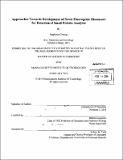Approaches towards development of novel fluorogenic biosensors for detection of small protein analytes
Author(s)
Cheung, Stephanie, S.M. Massachusetts Institute of Technology
DownloadFull printable version (11.66Mb)
Other Contributors
Massachusetts Institute of Technology. Department of Chemistry.
Advisor
Barbara Imperiali.
Terms of use
Metadata
Show full item recordAbstract
One of the most remarkable ideas in modem biology is that organization of multicellular life is orchestrated by a relatively small repertoire of signaling molecules, which mediate communication between cells. Breakdown of these communication pathways can have profound consequences, leading to a multiplicity of developmental defects and disease states. In particular, the ErbB family of receptors and ligands regulate key cellular processes such as proliferation, differentiation, and apoptosis during embryonic development, cellular homeostasis, and tumorigenesis. The generality of the ErbB-network has made it one of the most well-studied cell signaling systems. However, traditional methods used to study cellular signaling either fail to capture the dynamic nature of signaling networks or to lack the ability to quantify native signaling components. To further our understanding of the signaling processes that govern cell fate and tissue health, novel non-invasive techniques must be developed to quantitatively track native protein analytes in live cells. Herein approaches toward the development of a set novel fluorogenic biosensors capable of detecting native ErbB-ligands are reported. Using yeast surface display, two libraries of protein-binding scaffolds were engineered to bind selectively to human EGF and human betacellulin with low nM KD. Bio-orthogonal conjugation of these protein scaffolds to 4-DMN, a solvatochromic fluorophore, afforded a biosensor that exhibit a 3-fold fluorescence increase upon binding human EGF. Efforts to improve the fluorescent signal via alternative labeling strategies are also reported.
Description
Thesis: S.M., Massachusetts Institute of Technology, Department of Chemistry, 2014. Cataloged from PDF version of thesis. Includes bibliographical references.
Date issued
2014Department
Massachusetts Institute of Technology. Department of ChemistryPublisher
Massachusetts Institute of Technology
Keywords
Chemistry.